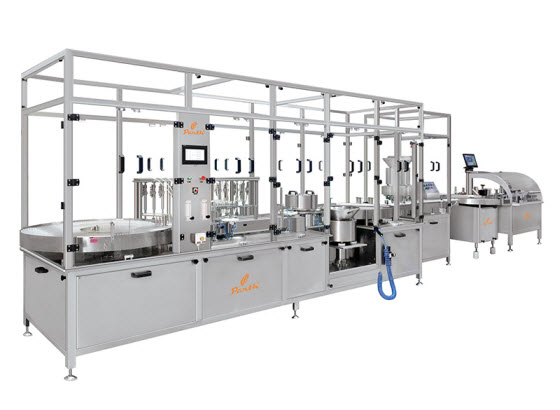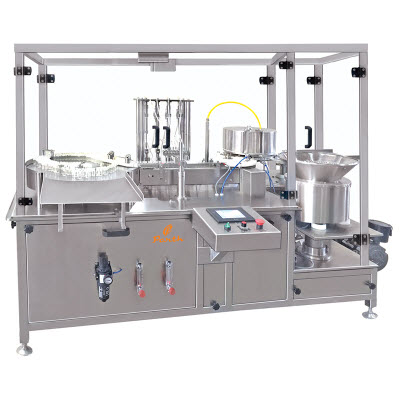For Export Enquiry
Call Us
Maintenance Tips and Best Practices for Injectable Liquid Filling Machines
Maintaining injectable liquid filling machines is crucial to ensure their reliability, efficiency, and the safety of the pharmaceutical products they dispense. Proper maintenance helps to minimize downtime, extend the machine’s lifespan, and ensure compliance with stringent industry regulations. Here is a detailed, step-by-step guide on the best practices and maintenance tips for injectable liquid filling machines:
Step 1: Regular Cleaning and Sterilization
Daily Cleaning:
At the end of each production run, perform a thorough cleaning of all machine parts that come into contact with liquid solutions. Use approved cleaning agents that are compatible with the machine materials and the pharmaceutical products.
Sterilization:
Depending on the type of product being filled, sterilization may be required between batches or at the end of a production day. Use methods such as steam, UV light, or chemical sterilants to ensure all components are free of contaminants.
Step 2: Routine Inspection
Visual Inspections:
Regularly inspect the machine visually to check for signs of wear and tear, such as leaks, cracks, or corrosion on any parts of the machine. Pay particular attention to seals and gaskets, as these are prone to degradation.
Check for Functionality:
Ensure that all mechanical and electrical components are functioning correctly. Test sensors, actuators, and other electronic components to ensure they are responsive and accurate.
Step 3: Lubrication
Lubricate Moving Parts:
Regular lubrication of the machine’s moving parts is essential to prevent friction and wear, which can lead to breakdowns. Use only the lubricants recommended by the manufacturer, as using the wrong type can cause damage or contamination.
Record Lubrication Schedules:
Keep a log of all lubrication activities, including the type of lubricant used and the date of application. This helps in maintaining a consistent schedule and ensures that no parts are overlooked.
Step 4: Calibration and Alignment
Calibrate Measurement Devices:
Regularly calibrate scales, flow meters, and other measuring devices to ensure they provide accurate readings. Calibration is crucial for maintaining product consistency and adhering to dosage requirements.
Check and Adjust Alignment:
Misalignment in the filling and capping mechanisms can lead to improper sealing and potential contamination. Regular checks and adjustments are necessary to maintain alignment.

Step 5: Replacement of Worn-Out Parts
Identify Worn-Out Components:
During regular inspections, identify any parts that are showing signs of excessive wear or damage and replace them immediately.
Use Original Parts:
Always use original or manufacturer-approved parts for replacements to ensure compatibility and reliability.
Step 6: Software Updates and Functionality Checks
Update Software:
Keep the machine’s software updated to the latest version. Software updates often include bug fixes, new features, and improvements that can enhance machine performance.
Functionality Checks:
Regularly test the machine’s automation systems and interfaces to ensure they are functioning correctly. This includes user interfaces, data logging, and alarm systems.
Step 7: Training and Documentation
Operator Training:
Ensure that all operators are thoroughly trained on the proper operation and maintenance of the machine. Regular refresher courses can help maintain high standards.
Maintain Documentation:
Keep detailed records of all maintenance activities, including dates, actions taken, and the personnel involved. This documentation is essential for tracking the machine’s maintenance history and for regulatory compliance.
Step 8: Preventive Maintenance Schedule
Develop a Preventive Maintenance Schedule:
Create a detailed schedule based on the manufacturer’s recommendations and real-world usage patterns. Adhering to a preventive maintenance schedule can prevent problems before they occur.
Review and Adjust the Schedule:
Regularly review the effectiveness of the maintenance schedule and make adjustments based on the actual conditions and performance of the machine.
Step 9: Emergency Preparedness
Prepare for Breakdowns:
Keep a stock of critical spare parts on hand to minimize downtime in case of a breakdown.
Establish Emergency Procedures:
Develop and train staff on emergency procedures for handling sudden machine failures or malfunctions.

Step 10: Engage with Professionals
Routine Professional Inspections:
Even with an in-house maintenance team, it’s beneficial to have the injectable liquid filling machine inspected periodically by a professional service provider. They can provide expert insights and identify issues that may not be apparent to internal staff.
Following these maintenance tips and best practices will help ensure that your injectable liquid filling machine operates efficiently, reliably, and safely, maintaining high productivity and compliance in pharmaceutical manufacturing.
We provide 24 x 7 Customer
Service & Support
Copyright © 2025, Parth Engineering & Consultant ( India ).
Web Design by Opal Infotech





